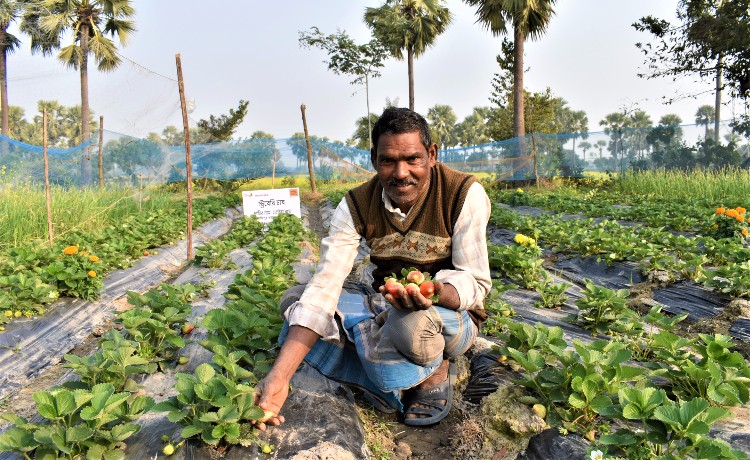In Abhla, Lakhipur, and other neighbouring villages in Farakka, an unfamiliar fruit brings hope and higher income. A strawberry called Winter Dawn.
In this socio-economically backward region of Farakka in Murshidabad district, West Bengal, most marginal farmers and sharecroppers work on plots averaging less than 1.5 hectares. (1 acre)
Cultivation was traditionally monsoon-dependant, yielding only a kharif crop. Here at the juncture of the Chhota Nagpur Plateau and the Gangetic Plain, farmlands are often at a higher level from the river that flows not too far away. Irrigation is a challenge.
To address the irrigation problem in Farakka, Ambuja Foundation encouraged farmers to adopt the River Lift Irrigation (RLI) system. Designed to pull water up to a height from a river, it enables irrigation and is transformative. RLI increases overall productivity and makes two, even three crops possible.
In search of a high value crop
Now that water was available, Ambuja Foundation – a firm believer in doubling farmers’ income – decided to explore high market value crops in areas where it was feasible to grow them. In the upland farms, farmers were urged to consider more profitable produce for the rabi season. That’s how strawberries first came to the fields of Farakka.
As India prospers, a taste for more exotic and expensive food is burgeoning. Dragon fruit, chia seeds, avocado… the Indian table is experimenting and open. However, farming communities in many parts of the country, certainly Farakka, have no prior knowledge of these crops. They are also hesitant to try something new.
Ambuja Foundation’s intervention aimed to help farmers step out of their comfort zone and truly impact earnings.
Strawberries had potential and would multiply income. But the fruit grows in cool climes. How would you grow it in farms where temperatures shoot up to 35 degrees Celsius after February? Ambuja Foundation in consultation with the Krishi Vigyan Kendra, identified the Winter Dawn variety which could be cultivated here. Farmers were given training, they also had to participate by contributing 50 percent of the cost of saplings, which was sourced from Maharashtra.
First steps with strawberries
However, not many farmers were convinced. Finally, in 2020, four small farmers agreed to plant strawberries in demonstration plots. Production was satisfactory, but the fruit is highly perishable, so Ambuja Foundation sourced packaging to support the endeavor. That year, the farmers realized a profit of Rs 200 (per kilogram). What they really enjoyed was the fact that from only 0.33 acre and in just about four months, they could realize such gains.
Winter Dawn takes root
The attractive profits and short investment period are paying off. Now almost 40 farmers have started cultivating Winter Dawn.
In Abhla village, Tetra Roy owns a 1-acre farm. In 2021, he grew the usual kharif crop of paddy and grass peas. Then for the rabi season, he opted for mostly mustard and potato, planting strawberries in a tiny corner of 0.03 acres. The strawberry output was 2.80 quintals, he earned Rs. 42,000 from it. His total income went up threefold from around Rs 40,000, in 2020 to Rs 1,40,000 in 2021, with almost 30% of it coming from strawberries.
There are even four or five women famers, “Didis”, growing strawberries now. In Farakka, Many women live without their husbands who are migrant labour. Before, the women worked at the hot, backbreaking brick kilns nearby. They earn much more from strawberries, without having to toil so hard. In Lakhipur, Srimati Mandal’s 0.33 acre yielded a first strawberry crop of 10.50 quintals and a net profit of Rs. 1,05,000. She plans to invest her earnings in the coming season’s cultivation and buy more land to produce high value crops.
This year, farmers saw up to 10 quintals of strawberry production from 0.33 acre. They are reporting almost Rs. 1.5 lakh in profit alone. Ambuja Foundation continues to support the farmers from farm to market. Next on the cards is teaching sapling production and establishing a nursery nearby. Ambuja Foundation is also working on minimizing wastage when temperatures suddenly rise.
Thanks to the luscious, red fruit that was quite unknown here until recently, lives are changing, incomes are rising, more children are going to school, and winter promises a new dawn.







0 Comment